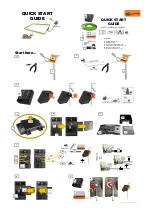
TCY-T0121 Intelligent Compact Controller
Version: 2004-07
Page 4/12
Analog Inputs:
The analog input signals may be configured with jumpers to 0-10V, 0-5V and 4-20 mA. The jumpers are located just
behind the terminal connector of each input. The drawings below indicate the jumper placement for each signal type.
The factory setting is 0-10 VDC.
The range of the input signal can be specified in software by
setting a minimum and a maximum limit. The limits are in
percent of the full range
The display value of the input signal may be specified. For
example a pressure sensor has a 4-20 mA output and a
pressure range of 0 – 200 Pa. It is possible to transform the
input signal into a different dimension by setting the minimum and maximum transformation value in the input
configuration setup. In our example the display will read 100 for a 12 mA signal.
Averaging function: Some sensor signals (for example air flow sensors) tend to fluctuate. The controller measures
every second the signal inputs. Select how many values should be used to calculate the averaging signal, which will
be used as control input. (Too many samples for an averaging signal may increase the swinging te ndency, increase
reset time on PI signals in this case)
Output Configuration
Analog Output
The analog output may be configured with jumpers for 0-10 VDC or 0-20 mA control signals. The jumpers are
located behind the terminal connector of the respective analog output. See table below for jumper placement. The
factory setting is to 0-10 VDC.
The signal range is specified in software by setting a
minimum and a maximum limit.
Each output may be assigned to a control loop, set to manual
or serve as a temperature feedback of the internal
temperature sensor. See parameter OP section for details:
Enabling OP-03 changes DO1 and DO1 into a floating output for a PI loop. In this case the running time of the
actuator needs to be specified. Running time is defined as the time required for the actuator to run from fully open to
fully closed or vise versa. Note that it is recommended to use only actuators with a fixed running time.
Once fully open or fully closed the running time for the actuator is extended for 5 minutes.
If OP-03 is in the OFF position, DO1 and DO2 may be used as switching outputs for an ON/OFF control module.
Digital Outputs
The switching outputs DO1 and DO2 are factory assigned as floating output. They may be assigned as digital outputs
using OP-07 to OP-08. The digital outputs may be used either as switching outputs for Temperature or Universal
ON/OFF modules. Each output needs to be assigned to a control loop. See parameter OP section for details.
Time schedule on digital outputs
The digital outputs may be used with an individual schedule. Select option 7 at the OP7/8 parameter. There are two
programs with each 4 switching times available. Program 4 and 5 applies for DO1 and Program 6 and 7 for DO2.
Schedule for Digital outputs will only operate if floating output is disabled (OP03 = OFF).
Switching difference on floating output
The controller moves the actuator to the calculated position by either opening or closing the actuator. The actuator
should not be moved for every little change in position, since this would reduce the lifetime of the actuator.
OP-06: Switching difference: The actuator will only move, if the difference to the current actuator position is larger
than this parameter.
Power Failure
All the parameters and set points are memorized and don’t need to be reentered. Depending on UP04 the unit will
remain switched off, switch on automatically or return to the operation mode it was in before the power failure.
Deluxe version only: Timer operation and daytime setting will be retained. (Battery factory mounted battery life is 2
years).
Frost Protection
The controller will enter frost protection mode if the room temperature drops below 5°C (41°F). All heating outputs
will be fully opened. Frost protection mode will be left once the temperature reaches 10°C (50°F). Frost protection
display will remain until a button is pressed. Frost protection can be enabled/disabled using user parameter UP-06.
Note: Frost protection uses the NTC temperature input. Analog sensors set as temperature sensor with 1U11 will not
be able to trigger frost protection
Clock Operation (Deluxe Version)
TLCY contains a battery backed quartz clock. Up to 16 mode changes (STANDBY, COMFORT, OFF) based on
weekdays and time may be programmed. See chapter operation on how to program and assign switch times to the
corresponding loops.
A blinking clock indicates that the battery is empty and needs to be replaced. The time needs to be set in order to
allow time programs to operate. See chapter operation, advanced settings for instructions on how to set the time.
Signal Type
Jumper selection
0 – 10 VDC
(1-4)
0 –5 VDC
(3-4)
0 – 20 mA DC
(2-3)
Signal Type
Jumper selection
0 – 10 VDC
(1-2)
0 – 20 mA DC
(2-3)






























